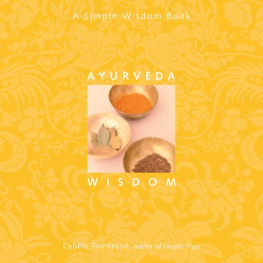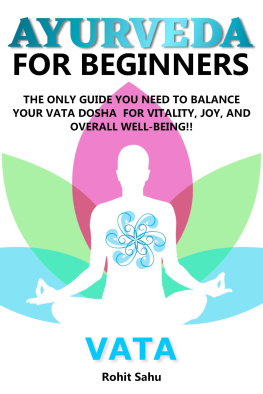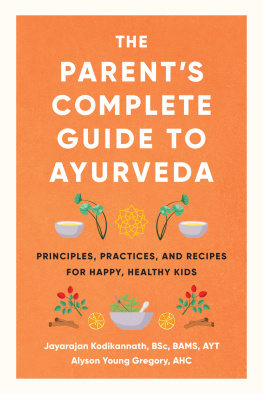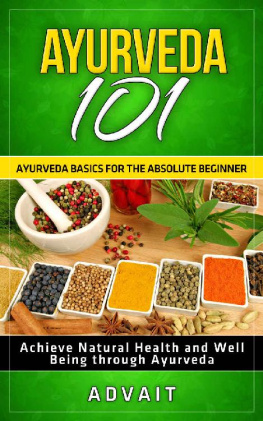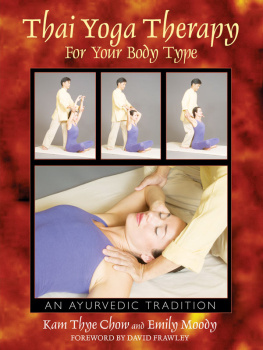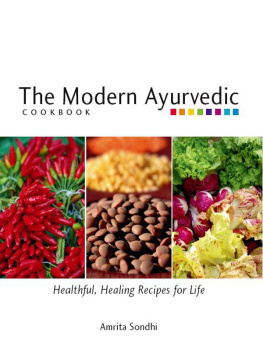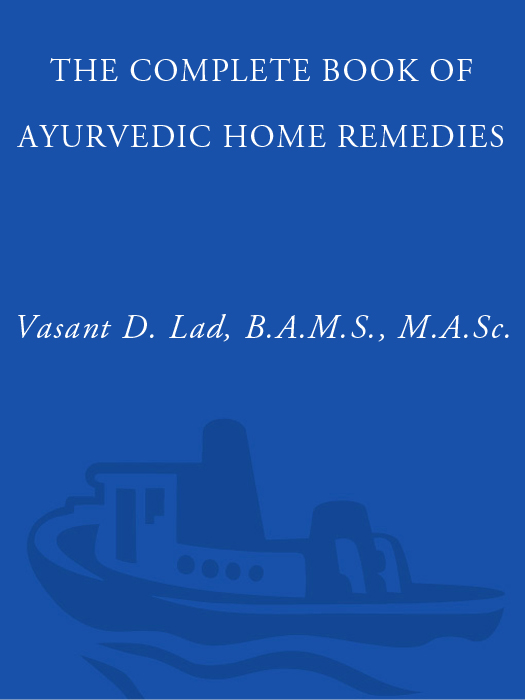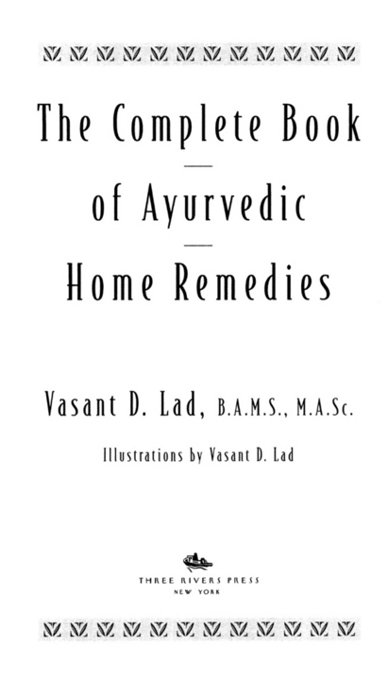Although the information contained in this book is based on Ayurvedic principles practiced for thousands of years, it should not be taken or construed as standard medical diagnosis or treatment. For any medical condition, always consult with a qualified physician.
Copyright 1998 by Vasant Lad, M.A.Sc.
All rights reserved. No part of this book may be reproduced or transmitted in any form or by any means, electronic or mechanical, including photocopying, recording, or by any information storage and retrieval system, without permission in writing from the publisher.
Published by Three Rivers Press, New York, New York.
Member of the Crown Publishing Group.
Random House, Inc. New York, Toronto, London, Sydney, Auckland
www.randomhouse.com
THREE RIVERS PRESS is a registered trademark and the Three Rivers Press colophon is a trademark of Random House, Inc.
Originally published in hardcover by Harmony Books in 1998.
First paperback edition printed in 1999.
Library of Congress Cataloging-in-Publication Data Lad, Vasant, 1943
The complete book of Ayurvedic home remedies / by Vasant D. Lad.1st ed.
Includes bibliographical references.
1. MedicineAyurvedic. I. Title.
R605.L263 1998 615.53dc21 97-27802
eISBN: 978-0-307-81591-0
v3.1
This book is dedicated with all my heart to my most loving wife,
Usha, and my children, Aparna and Pranav.
Contents
Appendix 1
How to Use the Healing Properties of Metals, Gemstones, Colors, and Aromas
Appendix 2
How to Prepare and Use Herbs, Ghees, and Oils
Appendix 3
Special Ayurvedic Procedures
Appendix 4
Yoga Asanas
Acknowledgments
The author would like to acknowledge those whose dedication and insight brought the knowledge of Ayurveda to the world, especially his teachers who lovingly showed the way and shared their knowledge and experience. He would also like to express his gratitude to the following people, without whose contributions this book would not exist. To his loving wife, Usha, and his children, Pranav and Aparna, for their love, patience, and support during the writing of this book. To Wynn Werner and the Ayurvedic Institute staff for their help with the original outline, the various drafts, and for raising important points during this process. To Jack Forem for proposing the idea for the book, and for help writing, organizing, and editing the material in a clear and enjoyable style. At Harmony Books, appreciation to Leslie Meredith and Peter Guzzardi for believing in the project, and to Joanna Burgess for her exacting attention in bringing the book to production.
Introduction
The Need for Healing
Ayurveda is the art of daily living in harmony with the laws of nature. It is an ancient natural wisdom of health and healing, a science of life. The aims and objectives of this science are to maintain the health of a healthy person and to heal the disease of an unhealthy person. Both prevention (maintenance of good health) and healing are carried out by entirely natural means.
According to Ayurveda, health is a perfect state of balance among the bodys three fundamental energies, or doshas (vata, pitta, kapha) and an equally vital balance among body, mind, and the soul or consciousness.
Ayurveda is a profound science of living that encompasses the whole of life and relates the life of the individual to the life of the universe. It is a holistic system of healing in the truest sense. Body, mind, and consciousness are in constant interaction and relationship with other people and the environment. In working to create health, Ayurveda takes into consideration these different levels of life and their interconnectedness.
As a science of self-healing, Ayurveda encompasses diet and nutrition, lifestyle, exercise, rest and relaxation, meditation, breathing exercises, and medicinal herbs, along with cleansing and rejuvenation programs for healing body, mind, and spirit. Numerous adjunct therapies such as sound, color, and aromatherapy may also be employed. The purpose of this book is to acquaint you with these natural methods, so you can make the lifestyle choices and learn the self-healing modalities that are right for you in order to create, maintain, or restore health and balance.
Ayurveda is a Sanskrit word that means the science of life and longevity. According to this science, every individual is both a creation of cosmic energies and a unique phenomenon, a unique personality. Ayurveda teaches that we all have a constitution, which is our individual psychobiological makeup. From the moment of conception, this individual constitution is created by the universal energies of Space, Air, Fire, Water, and Earth.
These five elements combine into the three fundamental energies, or doshas. Ether and air constitute vata, which is the energy of movement; fire and water constitute pitta, the principle of digestion or metabolism, the transformation of matter into energy; and water and earth make up kapha, the energy of structure and lubrication. When the male sperm and the female egg join at the time of fertilization, the vatapittakapha factors from the parents bodies that are most active and predominant at the moment, due to the season, the time, the emotional state, and the quality of their relationship, form a new individual with a particular constellation of qualities.
In modern terms we speak of this blueprint of the individual as our inherited genetic code; from ancient times Ayurveda has called it our prakruti or individual constitution, a constant factor that does not change throughout life. It is our own unique pattern of energy, our combination of physical, mental, and emotional characteristics and predispositions.
Though the underlying structure of our prakruti remains a fixed reality, our home base or essential individuality, it is constantly bombarded by numerous forces. Changes in age and in our external environment, alternating heat and cold as the seasons pass, our endlessly shifting thoughts, feelings, and emotions, and the quality and quantity of the food we eat continuously affect us. Unhealthy diet, excess stress, insufficient rest or exercise, and repressed emotions all disturb our doshic balance. Depending on the type of changes and the individuals underlying constitution, various ailments may develop:
Some individuals experience an increase or aggravation of kapha, leading to conditions such as colds, congestion, sneezing, and allergic manifestations, as well as attachment, greed, and possessiveness.
A pitta individual may become highly critical, angry, or perfectionistic, or may develop physical symptoms such as acid indigestion, heartburn, diarrhea, dysentery, hives, rash, or acne.
Vata imbalances may manifest as constipation, abdominal distention, sciatica, arthritis, or insomnia, along with psychological symptoms such as fear, anxiety, and insecurity.
All these illnesses and conditions, in addition to the countless others that lead to human suffering, are due to alterations in the bodys inner ecology. These upset the individuals balance, creating subtle biochemical changes that ultimately lead to disease. This is why the Ayurvedic system of medicine speaks of the need for healing for every individual in every walk of life.


